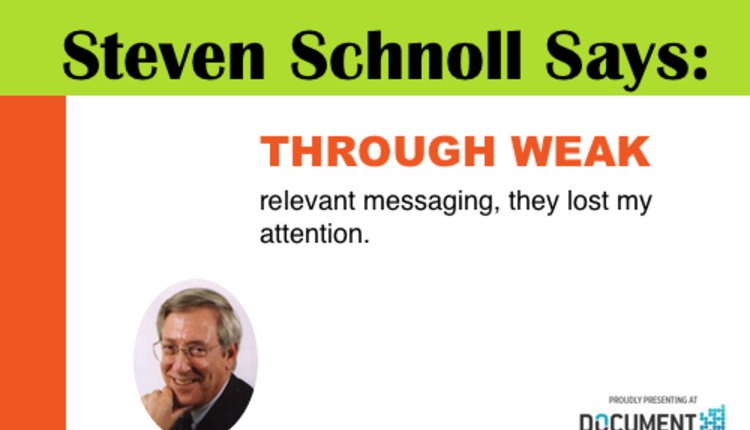One-to-one marketing is a customer relationship management (CRM) strategy emphasizing personalized interactions with customers. The personalization of interactions is thought to foster greater customer loyalty and better return on marketing investment. The concept of one-to-one marketing as a CRM approach was advanced by Don Peppers and Martha Rogers in their 1994 book, The One to One Future.
Only the term is new, however; the approach is almost as old as commerce itself. In the past, for example, proprietors of a general store would naturally take a one-to-one approach, remembering details about each customer's preferences and characteristics and using that knowledge to provide better service. One-to-one marketing seeks to reinvest marketing with the personal touch absent from many modern business interactions.
Today, consumers are fed up with the seemingly ever-increasing onslaught of marketing messages. In fact, the average consumer or business decision-maker is bombarded with over 1,500 marketing messages a day. Throughout all our waking hours, we are pounded by a rapid drum beat from a wide array of competitive channels: print, email, television, radio, web, telephone, test messaging, direct mail the list grows every day.
CONSUMERS ARE DEMANDING choice and control. They want to be presented with information and content that is of interest to them. They want to stop the overwhelming invasion of unwanted content in their mailbox as well as their inbox. In addition, they want to see businesses respond in environmentally sensitive ways by using less paper, less energy and less resources overall. These straightforward consumer perspectives bode very well for the future of one-to-one marketing since true one-to-one marketing addresses each of these concerns by communicating with constituents based on their interests, needs and wants; soliciting "opt-in" involvement; eliminating the waste of mass-media approaches; and communicating with fewer, more tightly targeted constituents.
Direct mail volume may be decreasing, but expenditures for broader direct marketing initiatives are increasing exponentially. Historically, the primary tool in a direct marketer's tool chest has been direct mail. As such, annual mail volumes grew year after year; both business-to-consumer (B2C) mail and business-to-business (B2B) mail volumes consistently grew every year through 2005.
A sea of change was building, however, as enterprise marketers began to understand the power of integrated direct marketing. Electronic media messaging blended strategically with print media messaging began to produce better results than "mail-only" efforts and provided the additional benefit of reducing costs at the same time.
The advancement of integrated media techniques coupled with the introduction of variable data printing means direct marketers can now create highly individualized content across a broad range of media: print-mail, where copy and graphics are unique for the recipient; email, where words and pictures are individualized; and PURLs, where e-reply pages can be customized for the individual respondent and also pre-populated with unique personal information that facilitates rapid, easy response along with verification of data.
THE FUTURE OF one-to-one marketing is strong. In fact, we are experiencing a shift away from mass marketing and towards one-to-one marketing, which is evident in the reviews of marketing expenditures of both Fortune 500s as well as small and medium-sized businesses.
"In 2008 and 2009, expenditures on direct marketing media and processes will again outpace general advertising by a slight margin," said Peter A. Johnson, PhD, Direct Marketing Association's (DMA) vice president/senior economist, Strategy, Analysis and Planning. "This means that in 2009, DM [direct marketing] will capture 53% of total advertising expenditures, continuing the long-term movement in advertising dollars to direct marketing from general advertising.
"Despite the current uncertain economic times and sluggish, even declining periods in the latter part of 2008, direct marketers should realize 3.7% nominal annual growth in sales this year," continued Johnson. "Direct marketing's integration of multiple sales channels and highly targeted offers means that businesses utilizing direct marketing typically outperform their competitors, even when sailing into financial headwinds. As the economy recovers in the latter part of next year, these advantages mean direct marketers will likely see sales growth of 4.5% next year. This improved revenue performance is forecast to help revive a US economy that desperately needs assistance."
"Direct marketing is now a bigger slice of an overall smaller marketing pie," added DMA research manager Yoram Wurmser, PhD.
Business leaders are seeking out savvy direct marketers who have a keen strategic sense, and they are including direct marketing counselors in C-level planning sessions. Statistically, there is proof that it cost less to retain and improve the relationship with a current customer than it does to acquire a new customer. Acquiring new customers can cost five times as much as satisfying existing customers, so it makes good business sense to work with direct marketing specialists who understand CRM and as such are highly qualified to lead the way to getting, keeping and growing profitable customer relationships.
THE TREND IN direct marketing is to apply solid, proven direct marketing techniques across a broad range of media in an integrated way to produce specific measurable results; however, mere integration of media is not the "holy grail" to increased results. Rather, it is the marketer's ability to deliver highly relevant messages to individuals based on specific, known characteristics.
Therefore, there is an increased emphasis around content relevancy. Delivery of relevant content is the big opportunity, currently, and will be in the future. Strategically sound, relevant content is not the banal overuse of an individual's name artistically rendered in everything from clouds to frosted window panes, to custom license plates found in far too many promotional materials today. By contrast, success rates are improved with the strategic use of information regarding a person's likes, affinities, memberships, buying behavior and other preferences to drive strategically smart content via both copy and graphics.
THE MARKETPLACE HAS long known the terms B2B marketing and B2C marketing. A relatively new term for an emerging trend is "B2I marketing." B2I is marketing communication emanating from a business and delivered to an individual - the penultimate form of marketing communications, where each word and each image are individualized for the recipient, whether on paper, computer screen or mobile display.
Throughout history, direct marketers have used a variety of techniques to simulate one-to-one communication, but the reality has been that at best what resulted were micro-segments of audiences and customized messages for each micro-segment, with an occasional splash of personalization. Now, however since print technology has caught up with data and e-technology, businesses can create unique messages for each individual and use any media or blend of media that is appropriate for that individual.
The basics still apply:
- Know your audience.
- Write compelling copy.
- Make strong offers.
- Choose your format(s).
- Time your delivery.
TODAY THERE EXISTS a plethora of potential touchpoint tools that facilitate a one-to-one marketing opportunity between marketers and their constituents. There has been much hype about the TransPromo opportunity, where a simple transactional document such as credit card statement or a utility invoice can be used as a vehicle to deliver individualized messaging to unique customers. The potential in this category is estimated to increase several billion direct marketing touchpoints a year. The approach that will catalyze this category of one-to-one marketing to grow exponentially is "organizational confluence," the coming together of marketing, data resources, creative and operations/production - all led by a corporate strategic vision.
MOBILE MARKETING IS also a relatively new one-to-one marketing tool. It follows logic that the mobile computing device (i.e. smart phone) is simply an extension of a PC. Successful one-to-one marketers are optimizing their message content and format to be delivered, read and acted upon by the mobile user. Mobile marketers are leveraging customer information along with GPS information to deliver highly individualized messages at most appropriate times, driven by the current location of the recipient.
MARKETERS ARE EXPERIMENTING with using social media in their marketing mix. There is no proven formula yet for integration of these social media tools, but one thing is clear: These new tools are most powerful in the hands of an organization's most satisfied customers. The key to success will be embedded in the nurtured relationship between the business and their most loyal customers. Social media are emerging as I2I tools.
The successful future of one-to-one marketing is bound to the practice of respecting the privacy of individuals. Use information that you know in respectful, meaningful ways and your constituents will grow closer to you. Use information wantonly and invasively, and you are doomed to failure. To reiterate the one common denominator of successful one-to-one marketing: The approach is invitational, not invasive!
The trend is for marketers to know more about their customers; to stimulate a value-based information exchange with their constituents; to use CRM data in meaningful ways to communicate more relevantly. Enterprise marketers, direct marketers and e-marketers are poised to leverage the one-to-one opportunity now more than ever before, to communicate relevantly, efficiently and effectively.
Jim Hackett [jhackett@indivia.biz] is president of Indivia, Inc., a full-service marketing and communications agency that specializes in Individualized communications. He has over 30 years of experience as a direct marketing practitioner.















